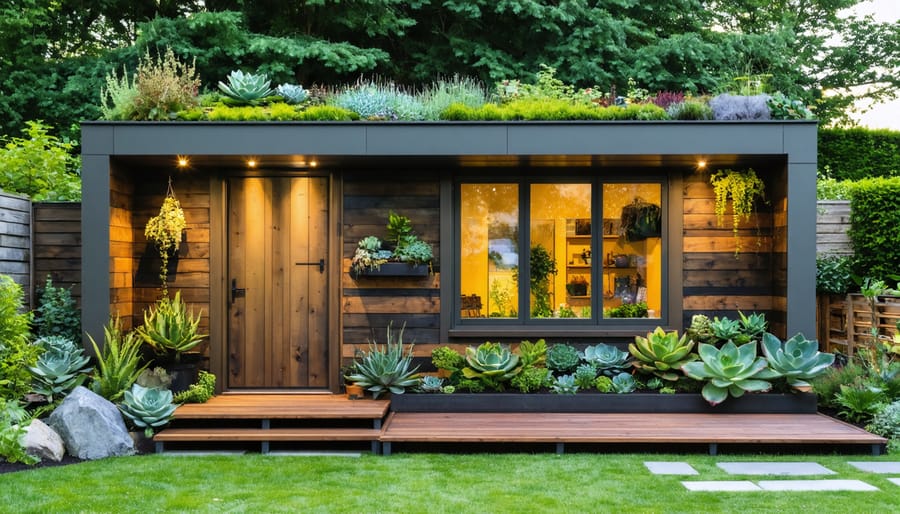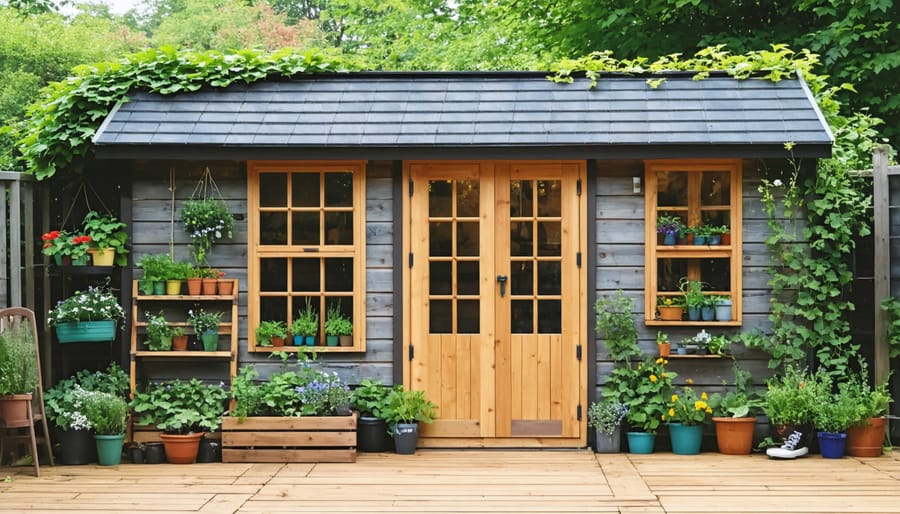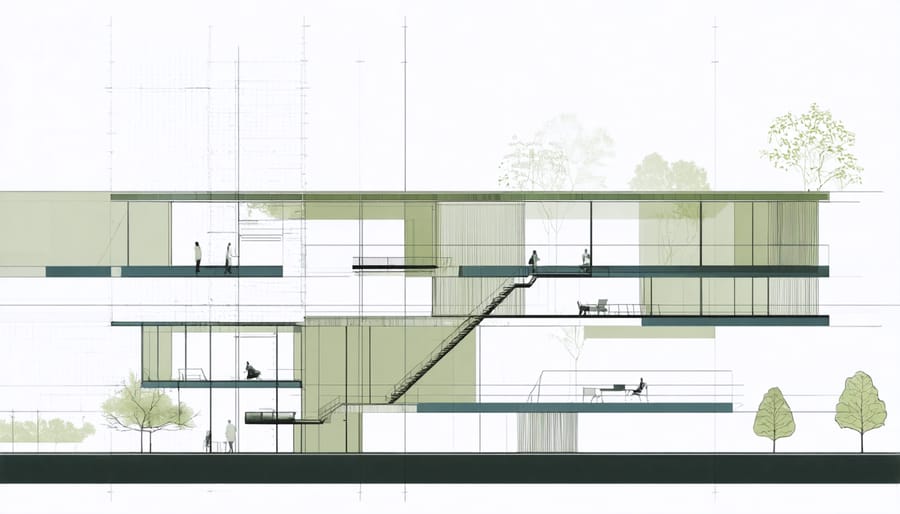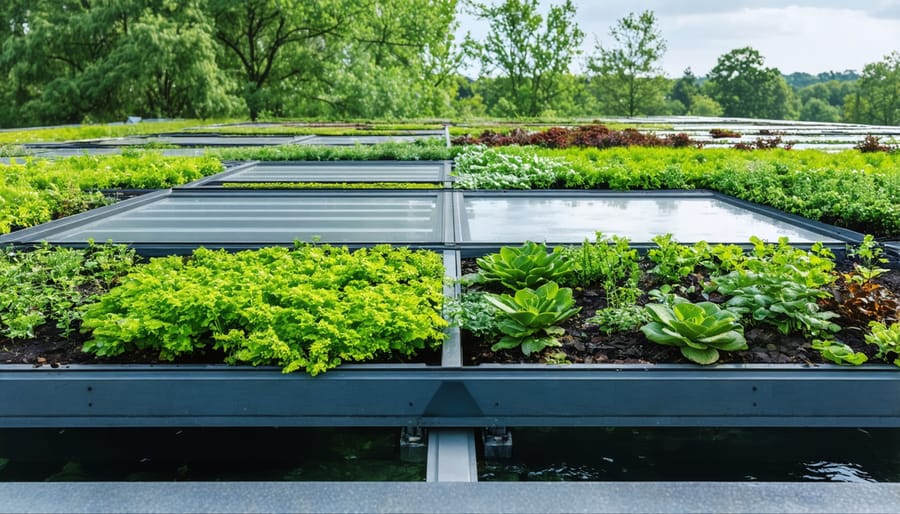Build an Earth-Friendly Storage Shed That Won’t Cost the Planet

Transform your backyard storage needs with free eco-friendly shed designs that combine functionality with sustainable building practices. Download ready-to-use blueprints from trusted DIY communities like BuildItSolar and FreeWoodworkingPlan, offering detailed materials lists and step-by-step construction guides. Customize classic 8×10 gable designs using reclaimed materials and passive solar orientation to reduce environmental impact while saving money. Select natural lighting solutions through strategically placed windows and transparent roofing panels, maximizing daylight hours and minimizing electricity usage.
Free shed plans democratize sustainable building, enabling homeowners to create lasting storage solutions without compromising environmental values or breaking the bank. Whether you’re storing garden tools, creating a workshop space, or designing a multipurpose outdoor room, these accessible designs provide the foundation for a practical, eco-conscious building project that adds genuine value to your property.
Sustainable Materials for Your Free Shed Design

Reclaimed Wood Options
Reclaimed wood offers an eco-friendly and character-rich option for your shed project while potentially reducing costs. Local salvage yards, demolition sites, and old barns are excellent sources for weathered lumber that can give your shed a unique, rustic appearance. Look for hardwoods like oak and maple, which offer superior durability even as reclaimed materials.
Before using reclaimed wood, ensure it’s free from pests, rot, and harmful chemicals. Many older boards may have been treated with substances no longer considered safe, so careful inspection is crucial. Clean each piece thoroughly and remove old nails or hardware. The extra effort pays off not only in sustainability but also in the distinctive weathered patina that new lumber simply can’t match.
Consider mixing reclaimed wood with new materials for structural elements where strength is paramount. Reclaimed timber works beautifully for siding, door construction, and decorative elements. Many DIY builders find success using old barn wood for accent walls or vintage doors repurposed as shed entrances, creating a perfect blend of functionality and historic charm.
Pro tip: Local architectural salvage businesses often maintain lists of upcoming demolitions, making it easier to source materials for your project.
Sustainable New Materials
In today’s environmentally conscious world, building your outdoor shed with sustainable materials isn’t just good for the planet – it’s also a smart long-term investment. Bamboo has emerged as a fantastic alternative to traditional lumber, offering exceptional durability and natural resistance to pests. This fast-growing material regenerates quickly, making it one of the most sustainable building options available.
Recycled metal components, particularly for roofing and structural supports, provide another eco-friendly option that pairs well with modular building techniques. These materials not only reduce landfill waste but often cost less than new materials while maintaining excellent durability.
Consider incorporating reclaimed wood into your shed design. Old barn wood, salvaged pallets, or repurposed lumber adds character while giving these materials a second life. Many DIY enthusiasts have found success using composite materials made from recycled plastics and wood fibers, which offer exceptional weather resistance and require minimal maintenance.
Cork is another innovative option for insulation and wall panels, harvested sustainably from cork oak trees without harming them. For roofing, recycled rubber tiles made from old tires provide excellent weather protection while keeping these materials out of landfills.
When selecting hardware and fixtures, look for items made from recycled metals or sustainable alternatives. Many manufacturers now offer eco-friendly options for hinges, handles, and fasteners that don’t compromise on quality or aesthetics. Remember, choosing sustainable materials doesn’t mean sacrificing durability or style – in many cases, these alternatives perform better than traditional options while helping protect our environment.
Energy-Efficient Design Elements

Natural Lighting Solutions
Natural light can transform your shed from a dark storage space into a bright, welcoming workspace while helping you create energy-efficient storage solutions. Strategic window placement is key to maximizing daylight throughout your structure. Consider installing windows on the east and west walls to capture morning and afternoon sun, respectively. For optimal lighting, aim to have windows comprise about 20% of your wall space.
Skylights are game-changers for shed lighting, especially in larger structures. Position them evenly across the roof to distribute light throughout the space. Solar tubes offer a cost-effective alternative to traditional skylights, providing excellent illumination while maintaining better insulation. For workbenches or potting areas, place windows at counter height to create well-lit task zones.
Don’t forget about ventilation when planning your window layout. Operable windows on opposite walls create cross-ventilation, helping regulate temperature and prevent moisture buildup. Consider installing translucent roofing panels along the ridge line for additional overhead lighting without compromising structural integrity.
For northern climates, south-facing windows maximize winter sun exposure, while roof overhangs help manage summer heat. Remember to factor in the surrounding landscape – trees and nearby structures can affect how much natural light reaches your windows throughout the day.
Passive Ventilation Techniques
Good ventilation is essential for keeping your outdoor shed dry and protecting your stored items from moisture damage. Incorporating passive ventilation techniques into your shed design is a cost-effective way to maintain proper airflow without relying on electrical systems. Start by installing roof vents near the peak of your shed, as hot air naturally rises and can escape through these openings. For optimal results, place one vent for every 150 square feet of floor space.
Adding soffit vents under the eaves creates a natural circulation pattern, allowing fresh air to enter from below while warm air exits through the roof vents. This continuous airflow helps prevent condensation and reduces the risk of mold growth. Consider installing adjustable gable vents on both ends of your shed, which you can open during warm weather and close during colder months to control airflow.
Strategic window placement also plays a crucial role in passive ventilation. Position windows on opposite walls to create cross-ventilation, and consider installing window screens to keep insects out while maintaining airflow. For added versatility, incorporate operable windows that can be opened or closed as needed.
Don’t forget about door ventilation – adding a gap at the bottom of your shed door or installing a vented door panel can significantly improve air circulation. If you’re building in a particularly humid climate, consider adding foundation vents near ground level to prevent moisture from becoming trapped underneath your shed.
Remember, proper ventilation not only protects your belongings but also extends the life of your shed by preventing wood rot and maintaining structural integrity.
Water-Smart Features

Rain Collection Systems
Adding a rain collection system to your shed is both environmentally friendly and practical. Start by installing gutters along the roof edges, ensuring they slope gently toward your desired collection point. A basic setup uses downspouts connected to rain barrels, which can store up to 50 gallons each. For larger storage needs, consider linking multiple barrels or investing in a larger cistern.
Position your collection containers on a sturdy, level platform made from concrete blocks or pressure-treated lumber. This elevation allows you to access stored water through a spigot at the barrel’s base. Install mesh screens at gutter entry points and barrel tops to keep out debris and insects.
For maximum efficiency, calculate your roof’s collection potential: one inch of rainfall on a 10’x10′ roof yields approximately 60 gallons of water. Consider adding a first-flush diverter to improve water quality by redirecting the initial runoff, which often contains the most contaminants.
Use collected rainwater for garden irrigation, cleaning tools, or washing your outdoor equipment. During dry spells, this stored water becomes an invaluable resource, reducing your reliance on municipal water supplies while supporting your outdoor activities.
Green Roof Options
A green roof system can transform your shed into an eco-friendly structure while adding natural beauty to your backyard. This living roof option involves installing layers of waterproofing membrane, root barrier, drainage material, and growing medium to support vegetation. For DIY enthusiasts, sedum and other low-maintenance succulents are ideal choices, as they’re drought-resistant and require minimal upkeep.
To create a successful green roof, start with a sturdy shed structure capable of supporting the additional weight – typically 20-30 pounds per square foot when saturated. Ensure your roof has a slight pitch (at least 1:12) for proper drainage while being gentle enough to prevent soil erosion. The installation process begins with a high-quality waterproof membrane, followed by a root barrier to protect your shed’s structure.
The growing medium should be lightweight and specifically designed for green roofs, usually consisting of a mix of organic matter and inorganic materials. Consider installing a simple irrigation system for the establishment period, though most green roofs become self-sustaining after plants are established.
Regular maintenance includes occasional weeding and ensuring drainage points remain clear. The reward? A beautiful, environmentally friendly roof that reduces stormwater runoff, provides natural insulation, and creates a habitat for beneficial insects and birds.
Free Design Resources and Plans
Online Plan Sources
Several reputable websites offer free eco-friendly shed designs that combine functionality with sustainable building practices. Ana White’s website features detailed DIY shed plans with step-by-step instructions and materials lists, focusing on using reclaimed wood and eco-conscious materials. MyOutdoorPlans.com provides a variety of free shed blueprints, including designs specifically created for incorporating solar panels and natural ventilation systems.
BuildWithRise.com hosts a collection of environmentally friendly shed designs, complete with suggestions for sustainable materials and energy-efficient features. Their plans often include options for green roofs and rainwater collection systems. The Natural Handyman website offers straightforward shed plans that emphasize the use of locally sourced materials and passive cooling techniques.
For those interested in more innovative designs, Instructables.com features user-submitted shed plans that incorporate creative recycled materials and unique sustainable elements. Popular Mechanics’ website maintains an archive of free shed plans, including several that focus on maximizing natural light and minimizing environmental impact.
Remember to check your local building codes before starting construction, as requirements may vary by location. Many of these websites also offer community forums where you can connect with other builders and share eco-friendly construction tips and modifications to existing plans.
Customization Tips
When you customize your shed design, you can transform a basic free plan into something uniquely suited to your needs while maintaining eco-friendly features. Start by analyzing your storage requirements and available space, then modify dimensions accordingly. Consider extending roof overhangs for better rainwater management or adjusting window placements to maximize natural lighting.
To enhance sustainability, incorporate salvaged materials into your modified design. Replace standard windows with recycled ones, or use reclaimed wood for decorative touches. You can also adapt the roof design to accommodate solar panels or create a living roof system for better insulation.
Make smart modifications to ventilation by adding extra vents or adjusting door placement for improved airflow. Consider incorporating a rainwater collection system by modifying the gutter design. For better organization, add customized shelving units or workbenches using sustainable materials.
Remember to maintain structural integrity while making changes. If extending the width or height, ensure proper support through additional studs or bracing. Create modular storage solutions that can be easily modified as your needs change. Add eco-friendly features like natural light tubes or passive ventilation systems that work with your local climate.
When modifying free plans, document all changes carefully and double-check load-bearing calculations to ensure safety and durability.
Embracing eco-friendly shed designs isn’t just good for the environment – it’s a smart investment in your property and future. By choosing sustainable materials and implementing energy-efficient features, you’re creating a storage solution that reduces your carbon footprint while potentially saving money in the long run. The free designs we’ve explored offer flexibility in size, style, and functionality, making it easier than ever to build a shed that aligns with your environmental values.
Remember that sustainable shed building doesn’t mean compromising on quality or aesthetics. From reclaimed wood and recycled metal to solar panels and natural lighting solutions, each eco-conscious choice contributes to a healthier planet while providing you with a practical and beautiful outdoor space. The satisfaction of building your own environmentally responsible shed extends beyond the completion of the project – it’s about being part of a larger movement toward sustainable living.
Ready to start your eco-friendly shed project? Begin by assessing your space, gathering sustainable materials, and selecting the free design that best suits your needs. Don’t forget to check local building codes and obtain necessary permits before breaking ground. With careful planning and the right resources, you’ll soon have a sustainable storage solution that serves as an inspiration to others in your community.
Take that first step today – your perfect eco-friendly shed awaits!

